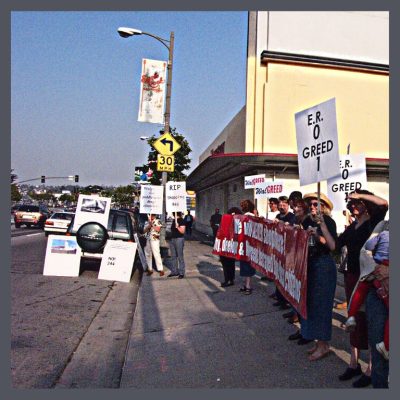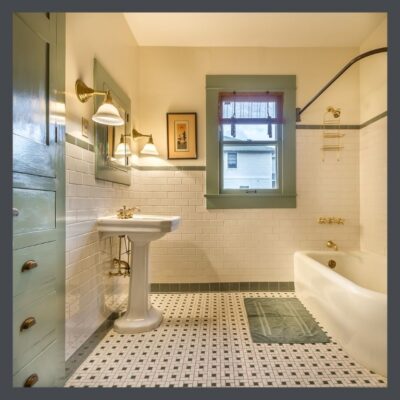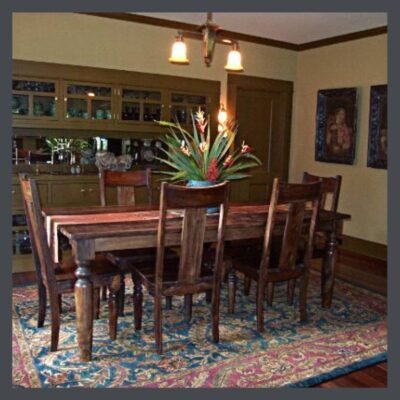 I wrote this article about restoring a bungalow the right wa-a-ay back when dinosaurs roamed the earth, around 2006 when I first moved to Tampa. I had left the little “town” of Eagle Rock, a historic neighborhood in N.E. Los Angeles, left the Hare House, a beautiful bungalow on the L.A. Historic Register which I had meticulously restored (the right way!), but brought with me new determination & a shiny new soapbox, after being defeated in the saving of the wonderful historic building, at our corners of Main & MainWe had fought a valiant fight, but greed & lack of our councilman’s foresight (He got slammed in the next election.) won out so instead of being treated to a view of one of the world’s most wonderful (& scarce) Streamline Moderne buildings on this planet, when you shop downtown, you encounter a Walgreens, sitting in a sea of parking.
I wrote this article about restoring a bungalow the right wa-a-ay back when dinosaurs roamed the earth, around 2006 when I first moved to Tampa. I had left the little “town” of Eagle Rock, a historic neighborhood in N.E. Los Angeles, left the Hare House, a beautiful bungalow on the L.A. Historic Register which I had meticulously restored (the right way!), but brought with me new determination & a shiny new soapbox, after being defeated in the saving of the wonderful historic building, at our corners of Main & MainWe had fought a valiant fight, but greed & lack of our councilman’s foresight (He got slammed in the next election.) won out so instead of being treated to a view of one of the world’s most wonderful (& scarce) Streamline Moderne buildings on this planet, when you shop downtown, you encounter a Walgreens, sitting in a sea of parking.
I moved across the country, to one block away from a man who had defeated Walgreens, saving a block of historic bungalows & happily worked side-by-side in our neighborhood’s historic preservation committee with him until he died too soon. We had our work cut out for us in our neighborhood. Bisected by the I-275 in the early 70’s, the neighborhood suffered a sharp decline.
By the time I arrived in 2005, the neighborhood association had used its teeth to ignite a Renaissance, but what this meant was that our houses were ripe for flippers, looking to make a quick buck at our neighborhood’s expense. After experiencing a broken heart over & over in the search for my own bungalow, as I witnessed historic materials having been removed for builder grade garbage, I wrote this article for my wood flooring website. I was addressing homeowners, encouraging them to employ best preservation practices to their own historic bungalows, but hoped it would spill over to the flippers who cared zero about the neighborhood or history. A girl can dream!
RESTORING A BUNGALOW – THE RIGHT WAY-2006
Be a wise investor. Follow market trends & spend your money with an eye to the future- historic rehabilitation, rather than remodeling, modernizing or budget fix-up’s.
An older home is no different from any other antique. Would you replace the handles of a priceless Ming vase with new plastic ones in order to “modernize” or improve its use as a pitcher? Nope. It would be disrespectful to the culture & the artist who produced it & it wouldn’t be economical. You would reduce its value as an antique!
Craftsmanship has declined & the costs of both labor & materials have skyrocketed since these houses were built. You could not build a comparable house today for what you would pay for a fine old home with its antique features & wonderful character.
Here are some things I did (& did not do) & will (& will not do) to increase my home’s comfort, value & appeal, as well as lovingly preserve it for the next fortunate steward:
1. I researched my style of house, the bungalow, as well the philosophy behind its particular design, so that I could make correct decisions regarding its rehabilitation. It saved me much money & grief to learn from the experiences of others.
2. I DID NOT destroy historic materials. Where something needed repair, I gently repaired it, I did not replace it. Plaster, for example, provides a much more lovely surface than drywall & it is not difficult to patch. Wood floors can often be refinished. Do not replace them unless they are worn to below the tongue & groove. And if you must install new, use real wood. I had my lovely old wood windows restored when I painted my interior walls & they work smoothly, giving me a lovely, old world look into my gardens. It was not costly, which replacements would have been.
 3. I did not remove or alter any character defining features. I DID NOT try to “modernize” or “improve” the house. I did not add odd bits of architecture, appropriate to other periods or styles of house. Consider how horrid a 60’s bathroom looks in a bungalow today. Well, 40 years from now, the currently fashionable spa style bathroom will strike the eye with the same degree of discord. Install a new “bungalow” bathroom (or one that suits the period of your old house) & it will never go out of style!
3. I did not remove or alter any character defining features. I DID NOT try to “modernize” or “improve” the house. I did not add odd bits of architecture, appropriate to other periods or styles of house. Consider how horrid a 60’s bathroom looks in a bungalow today. Well, 40 years from now, the currently fashionable spa style bathroom will strike the eye with the same degree of discord. Install a new “bungalow” bathroom (or one that suits the period of your old house) & it will never go out of style!
4. I handled the structural problems discovered in my pre-purchase home inspection, & I replaced the roof. Water intrusion destroys houses. I am ever watchful for signs of leaks.
5. I got my wood treated with Borates, naturally occurring mineral salts that are deadly to termites, carpenter ants & roaches. Considered harmless to humans & ecofriendly, I had all the wood that could be reached in the attic, crawlspace & everywhere, treated. I have my house inspected at least twice a year & keep an eagle eye out for signs of any & all types of nasty, wood destroying organisms.
6. Landscaped with plants that would do well in our climate & complement the style of my house. I did not use many Florida natives, instead going for an exotic tropical look, but I do recommend natives. I feed my plants with organic fertilizers & water the majority of them with a drip system which conserves water.
7. I planted a couple feet away from the house so moisture from the plants did not destroy the siding & it gave me room to do periodic inspections. I got new gutters which I had cleaned every year & put gutter extenders on them to run the water away from the house. My banana trees loved it!
8. I painted the exterior of my house with period appropriate colors. I made sure that all surfaces, inside & out, were well prepared so that the paint would adhere well & look good. If you have shingles, that have never been painted, keep them that way. Do not paint them. Just re-stain them. If some are damaged, replace those.
9. DO NOT stucco or put up siding which can become a haven for termites, rats and roaches & mold, & reduce the value of your property. If your house has these coverings, they actually can be removed. Often, the surface underneath is in surprisingly good condition!\n\n
 10. I rebuilt the glass doored cabinets in the living room & dining room that had been removed by a previous owner. Prior to installing them, I photographed the areas where they would sit, documenting the fact that they were added, not original. I passed this information on to the person who bought my house.
10. I rebuilt the glass doored cabinets in the living room & dining room that had been removed by a previous owner. Prior to installing them, I photographed the areas where they would sit, documenting the fact that they were added, not original. I passed this information on to the person who bought my house.
11. I joined my bungalow neighborhood association & Tampa Preservation, Inc. I raised my voice for the built environment of our past. I encouraged others to raise theirs-LOUD!
12. Nearly 20 years later, I started a blog about bungalows, America’s favorite house. I’m hoping that my stories educate, enlighten & empower you in restoring a bungalow the right way!
 STAY IN THE BUNGALOW KNOW!!!
STAY IN THE BUNGALOW KNOW!!!
Sign up for our newsletter & receive our FREE E-book, 7 VITAL Things to Do Before You Hire a Contractor.



I am very impressed. This site would be extremely useful for those who own or will own a bungalow. I think that there are many who like the look & feel of bungalow houses but don’t know how to mend past abuses. If they go to the usual home supply places they will get bad and/or ignorant advice.
Congratulations on a great project. Excelsior!
I am so happy that you consider it to be helpful. And, yes, there are many ignorant solutions at the Big Box stores!